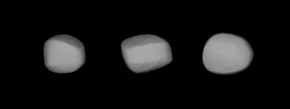69 Hesperia
Appearance
 A three-dimensional model of 69 Hesperia based on its light curve. | |
| Discovery | |
|---|---|
| Discovered by | G. Schiaparelli |
| Discovery date | April 29, 1861[1] |
| Designations | |
| (69) Hesperia | |
| Pronunciation | /hɛsˈpɪəriə/ hes-PEER-ee-ə |
Named after | Hesperia |
| Main belt | |
| Orbital characteristics | |
| Epoch (absent) | |
| Aphelion | 3.471 AU (519.3 Gm) |
| Perihelion | 2.489 AU (372.3 Gm) |
| 2.980 AU (445.8 Gm) | |
| Eccentricity | 0.165 |
| 1,879 days (5.14 a) | |
| Inclination | 8.59° |
| Physical characteristics | |
| Dimensions | 138 km (IRAS)[2] 135x106x98 km[3] 110 ± 15 km[3] |
| Mass | (5.86±1.18)×1018 kg[4] |
Mean density | 4.38±0.99 g/cm3[4] |
| 5.655 h[2] | |
| 0.140[2] | |
| M | |
| 7.05[2] | |
69 Hesperia (/hɛsˈpɪəriə/ hes-PEER-ee-ə) is a large, M-type main-belt asteroid. It was discovered by the Italian astronomer Giovanni Schiaparelli on April 29, 1861[1] from Milan. It was his only asteroid discovery. Schiaparelli named it Hesperia in honour of Italy (the word is a Greek term for the peninsula).[5]
Hesperia was observed by Arecibo radar in February 2010.[3] Radar observations combined with lightcurve-based shape models, lead to a diameter estimate of 110 ± 15 km (68 ± 9.3 mi).[3] In the near infrared, a weak absorption feature near a wavelength of 0.9 μm can be attributed to orthopyroxenes on the surface.[6] A meteorite analogue of the reflectance spectra from 69 Hesperia is the Hoba ataxite.[7]
References
- ^ a b "Editorial Notice" (PDF). The Minor Planet Circulars. MPC 94743-95312: 94743. 2015-08-29. Retrieved 4 September 2015.
- ^ a b c d "JPL Small-Body Database Browser: 69 Hesperia" (2011-09-07 last obs). Jet Propulsion Laboratory. Retrieved 2012-01-27.
- ^ a b c d Shepard, Michael K.; Harris, Alan W.; Taylor, Patrick A.; Clark, Beth Ellen; Ockert-Bell, Maureen; Nolan, Michael C.; et al. (2011). "Radar observations of Asteroids 64 Angelina and 69 Hesperia" (PDF). Icarus. 215 (2): 547–551. Bibcode:2011Icar..215..547S. doi:10.1016/j.icarus.2011.07.027.
- ^ a b Carry, B. (December 2012), "Density of asteroids", Planetary and Space Science, vol. 73, pp. 98–118, arXiv:1203.4336, Bibcode:2012P&SS...73...98C, doi:10.1016/j.pss.2012.03.009. See Table 1.
- ^ Schmadel, Lutz D. (2003). Dictionary of Minor Planet Names. Springer Science & Business Media. p. 22. ISBN 978-3-540-00238-3.
- ^ Hardersen, Paul S.; et al. (May 2005), "Near-IR spectral evidence for the presence of iron-poor orthopyroxenes on the surfaces of six M-type asteroids", Icarus, 175 (1): 141−158, Bibcode:2005Icar..175..141H, doi:10.1016/j.icarus.2004.10.017.
- ^ Neeley, J. R.; et al. (August 2014), "The composition of M-type asteroids II: Synthesis of spectroscopic and radar observations", Icarus, 238: 37−50, arXiv:1407.0750, Bibcode:2014Icar..238...37N, doi:10.1016/j.icarus.2014.05.008.
External links
- Bareket Observatory (Asteroid 69 Hesperia movie - through an Earth-based telescope.) Template:He icon
- 69 Hesperia at the JPL Small-Body Database
